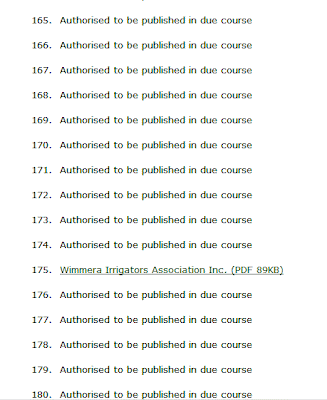This is the text of the Professional Fishermen’s Association submission sent to the House Standing Committee on Regional Australia’s Inquiry into the impact of the Murray-Darling Basin Plan in Regional Australia in which the Association tells the Committee:
The following brief submission is referred to you for consideration by the Inquiry members.
Diverting the Clarence River is not an option in our view and any consideration of this should be rejected outright. The Clarence River is the base for the largest commercial fishery in NSW. Some 150 active commercial fishers catch a range of species in the river and offshore from the mouth of the river at different times of the year .The species include the following and are caught in varying quantities depending on seasonal conditions.
eastern school whiting, stout whiting, sand whiting, flathead, bream, mullet, luderick, mud crab, blue swimmer crab, eel, herring, silver biddy, garfish, leather jackets, octopus, redfish, balmain bugs, deepwater bugs, cuttle fish, squid, (arrow, bottle and calamari), eastern king prawns, royal red prawns, school prawns, tiger and endeavour prawns, squid, snapper, pearl perch, morwong (red and rubberlip), yellow tail kingfish, bonito, long tail tuna, mack tuna, cobia, spanish mackerel, spotted mackerel, wahoo, mulloway, samson, sweep, amberjack, scorpio fish (red rockcod), tailor, tarwhine, trevally, teraglin, parrot fish, yellow fin tuna, bar cod, sand crabs, coral crab, red mullet (barbounia), pop eye cod, john dory, black tip and sand shark, yellowtail scad.
Many of these species spend part of their life cycle in estuaries including the Clarence and rely upon nutrients, water flows and the like to survive, reproduce and to maintain stock levels which in turn provides a range of sustainable fisheries in NSW. Fresh water flow is essential to the well-being of the river including ecosystem health and biodiversity within the river system.
One of the biggest fisheries on the Clarence is the Estuary Prawn Trawl (EPT) fishery. The catch varies, due to a range of reasons including freshwater flow levels, but averaged 375 tonnes per year over the past 25 years. The highest catch volume in that period was 597.9 tonnes in 1984/85 with 595.9 tonnes caught in 1988/89. The EPT industry relies on fresh water flow regime to stimulate growth, spawning and it greatly assists catch levels as the river is closed to trawling above the Ulmarra ferry.
Diverting water from the Clarence River will result in a decreased flow of freshwater and this combined with the tidal regime pushing saltwater further upstream will result in the fishery being destroyed as the stock will be upstream and outside the fishing area for the EPT.
The Clarence is also a large producer of finfish (mullet, bream, whiting, flathead, luderick), crab, eel and other seafood. The catch of these species averages about 500 tonnes per year. The reduction of the water flow, through diversion, and the subsequent decrease in nutrient loads will reduce the supply of seafood and will also impact on life cycle of the species in the river and immediately offshore.
The Clarence River fisheries are an important seafood supply source. With food security high on the agenda for Australia the commercial fishing industry on the Clarence and the adjacent ocean plays an important part of the food supply for this nation.
To replace the world’s fish catch by land grown meat, an area equal to twenty-two times the world’s rainforest would be required.
The commercial fishing industry on the Clarence is in the top two industries for output and employment. It is an extremely important industry for the social fabric of the Lower Clarence region. A recently completed socio-economic evaluation of the commercial fishing industry in the Clarence identifies the critical importance of the industry to the area. A copy of that report is provided for the Inquiry and the following two paragraphs are an example of the content of the report.
“The Lower Clarence area which is home to the majority of fishers in Northern NSW area has a fairly high level of socio-economic disadvantage, therefore the employment and income generated by the industry, though relatively small, remains important in the local economy. The long term connection of fishermen and their families to their local area suggests that they make up an important part of the local community and contribute to the social fabric of the towns they live in.
In a future where the sustainability and security of food resources will become so important, it is vital that the local commercial fishing industry is supported both by government and the wider community. People need to recognise the contribution of the industry to the provision of local and regional food security, and the efforts the industry has made to ensure that the harvest of resources remains sustainable. It is important that the productive capacity and the unique skill-set of commercial fishers are maintained. The development of new markets, value adding and the full utilisation of the harvested product will assist in maintaining the viability of the commercial fishing industry into the future.”
The commercial fishing industry on the Clarence generates $92M output, $15.4M income and, 431 employment positions.
The Professional Fishermen’s Association is fundamentally opposed to any diversion of water from the Clarence River. We support the Clarence community views that have been said repeatedly ‘not a drop’.
Labels: commercial fishing industry, environment, Regional Australia Committee, water policy politics


